Recorded Crime in Scotland, 2013-14
Recorded Crime in Scotland, 2013-14 Statistical bulletin
This document is part of a collection
2. Main Findings: Recorded Crimes and Offences in Scotland
Following the establishment of Police Scotland on 1 April 2013, 2013-14 is the first year in which this bulletin reports on statistics for the single police service. Since there are now no individual police force areas, it is no longer appropriate to show data at legacy police force level.
Clearly, there are limits to the amount of information which can be shown in the tables in the bulletin. Therefore these tables are restricted to high level figures (for example Scotland level) and selected crime types at local authority level. Tables 5 to 8 contain data for the top 35 crime and offence categories over a ten year time series. The accompanying data file contains the same version of these tables but allow the user to select a local authority to look at in more detail.
A set of additional tables will also be made available which will allow the user to look at a ten year time series across all local authorities for a chosen crime/offence or crime group. These tables will be made available via the following web link and users will be notified of their publication via ScotStat: http://www.scotland.gov.uk/Topics/Statistics/Browse/Crime-Justice/Datasets/RecCrime
TOTAL RECORDED CRIME
Recorded crime is now at the lowest level since 1974. The total number of crimes recorded by the police in Scotland in 2013-14 was 270,397. This is 1% lower than the level recorded in 2012-13 (Chart 1 and Table 1). This continues a steadily decreasing trend in recorded crime in Scotland over the last 23 years, from a peak in 1991 when crime reached a record high of 572,921.
On 1 April 2004, the Scottish Crime Recording Standard (SCRS) was introduced to help maintain a victim orientated approach to crime recording and was anticipated to increase the number of minor crimes recorded such a vandalism and minor thefts. We can see from Chart 1 that this did cause a slight increase in 2004-05 as expected, but that the downwards trend returned following this change to recording practice.
Chart 2 shows the number of recorded crimes in each of the five crime groups since 1971 and gives an indication of the scale of each crime group. These individual groups will be discussed in more detail in the sections which follow.
Chart 1: Crimes recorded by the police, 1971 to 1994 then 1995-96 to 2013-14
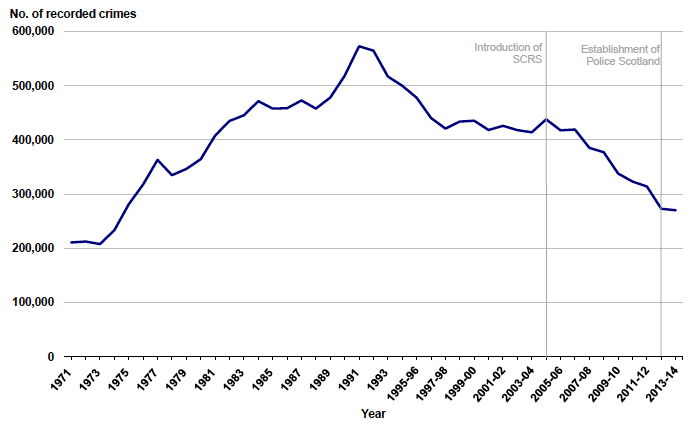
Chart 2: Change in total recorded crime between 2004-05 and 2013-14, by crime group
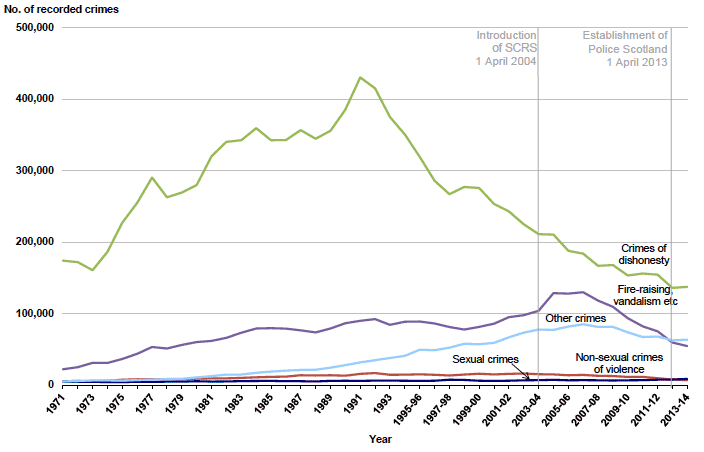
1. Comparable clear up rates for the current crime groups are not available prior to 1976.
HMICS audit
HMICS tested the accuracy of crime recording through an audit of records recorded between 1 April 2013 and 30 June 2014, taking into account areas identified as weak in previous audits, areas of high risk or emerging concern, and national and local policing priorities. HMICS audited records in six categories, four of which related to specific crime types:
- Sexual crime
- Violent crime
- Housebreaking
- Hate crime
- Non-crime related incidents
- No-crimes
The HMICS crime audit found that 'the quality of most incident and crime recording decisions by Police Scotland is good. 92% of incidents were closed correctly[5] and 94% of crime was counted and classified correctly'.
This bulletin reports on the number of crimes and offences recorded by the police in Scotland.
The HMICS Crime Audit 2014 found that 94% of crimes and offences were counted and classified correctly (Test 2). The chances are 19 in 20 that the 'true' value will fall within the range ± 1.4% from the sample results (i.e. approximately between 92.6% and 95.4%).
92% of incidents were closed correctly (Test 1). The associated 95% confidence interval is 92% ± 1.1% (i.e. approximately between 90.9% and 93.1%).
The report also shows that 94% of the almost 1,000 cases which were initially thought to be a crime but were later re-designated as not being a crime following additional investigation, were found to have been no-crimed correctly. The chances are 19 in 20 that the 'true' value will fall within the range ± 2.7% from the sample results (i.e. approximately between 91.3% and 96.7%).
Users of these crime statistics can therefore have confidence that crimes are being classified and counted correctly.
We also know from the audit that there are some incident records which have not been closed correctly, for various reasons. However, the technical errors found by HMICS in its examination of non-crime related incidents would not necessarily result in the under recording of crime.
Furthermore, it is not possible to determine the exact number of incident records which indicated that a crime had occurred, as many were closed with insufficient information from which to make a judgement as to whether or not a crime had occurred.
Compliance rates in relation to specific crime types, as well as for divisions, are reported in subsequent sections of this bulletin.
Key points from the Scottish Crime and Justice Survey:
The latest figures from the SCJS estimate that there were 815,000 incidents of crime against adults in Scotland in 2012-13, 22% lower since the 2008-09 survey. The survey estimates that, in 2012-13, around one in six (16.9%) adults aged 16 or over were the victim of at least one crime.
Comparison with recorded crime (comparable crime subset):
Of the 815,000 crimes estimated by the 2012-13 SCJS, just under two-thirds (527,000) can be compared with police recorded crimes. Further detail on the comparable crime set is available in Section 3.3 and in Annex 5 of the 2012-13 SCJS.
Both recorded crime figures and SCJS estimates show downward trends in the extent of comparable crime between 2008-09 and 2012-13 (-33% and -28% respectively). The reduction in estimates across all sweeps of the SCJS, from 731,000 in 2008-09 to 527,000 in 2012-13, is a statistically significant change. However, the short-term change in SCJS comparable crime between 2010-11 and 2012-13 is not a statistically significant change (at the 95% confidence level).
At this stage, it is difficult to identify trends in the relationship between recorded crime and SCJS estimates using only four sweeps of comparable data and we do not have enough evidence to make confident assertions about longer-term trends in SCJS estimates in the comparable crime subset prior to 2008-09. It is likely that greater certainty in trends will emerge over longer timescales, therefore continuing this analysis in future years will help to assess whether some of the short term changes reported here mark the beginning of a consistent pattern.
Local Authority analysis:
The overall decrease in recorded crime was reflected in 21 of the 32 local authority areas. Year on year figures can vary across local authorities, however the long term trend is broadly the same across Scotland. Chart 4 shows that over the ten year period covered by the bulletin, all local authorities are showing a decrease in recorded crime, varying from just under a third to just over a half
The largest decrease in recorded crime in 2013-14, was in Eilean Siar (30%) where 53% of the decrease was accounted for by decreases in Other thefts, Drug crimes and Sexual assault.
In the Shetland Islands, the Orkney Islands and in East Renfrewshire, the overall decrease was 17%. In the Shetland Islands, the decrease was driven by a 52% decrease in Vandalism etc. while on the Orkney Islands, Other Theft and Crimes against public justice accounted for 76% of the decrease. In East Renfrewshire, Shoplifting, Vandalism etc. and Drug crimes were the main drivers of the decrease, accounting for 48% of the decrease.
It should be noted that in all four of these areas, overall numbers of crimes are small and therefore subject to more fluctuation.
Ten local authorities have noted an increase varying from 1% in the Scottish Borders and Renfrewshire, to 14% in Edinburgh City, while Dumfries & Galloway saw no change from 2012‑13 (Chart 3).
In Edinburgh City, 75% of the increase was accounted for by Crimes of dishonesty, in particular Housebreaking and Other theft. In Midlothian, 82% of the increase was also accounted for by Crimes of dishonesty while in Fife 42% of the increase was due to an increase in Sexual crimes.
Further explanation of these trends is set out in the following sections under each crime group.
HMICS Audit
The HMICS Audit report states that 'a few divisions performed very well, achieving high compliance rates in all or most areas'. However, the report goes on to state that 'conversely, a few divisions performed poorly'.
Divisional compliance rates for Test 1 ranged from 83% to 99% and for Test 2 from 88% to 98%.
The lowest Test 2 compliance rate was for Ayrshire at 88%. The 95% CI for the Test 2 compliance rate is ± 5% and so the chances are 19 in 20 that the 'true' value will fall within the range (83% to 93%). The division of Ayrshire comprises the following three local authorities: East Ayrshire, North Ayrshire and South Ayrshire.
The Test 1 compliance rate was 90% or below for four of the 14 divisions, namely Edinburgh, Ayrshire, Argyll and West Dunbartonshire, and Renfrewshire and Inverclyde. Furthermore, the no-crime compliance rate is below 90% for the last three of these divisions.
Readers should be aware of these factors when considering information relating to these four divisions.
The following table shows the local authorities within these divisions:
| Division |
Local authorities |
|---|---|
| Edinburgh |
Edinburgh City |
| Ayrshire |
East Ayrshire, North Ayrshire and South Ayrshire |
| Argyll and West Dunbartonshire |
Argyll & Bute and West Dunbartonshire |
| Renfrewshire and Inverclyde |
Renfrewshire and Inverclyde |
Chart 3: Change in total recorded crime between 2012-13 and 2013-14, by local authority area
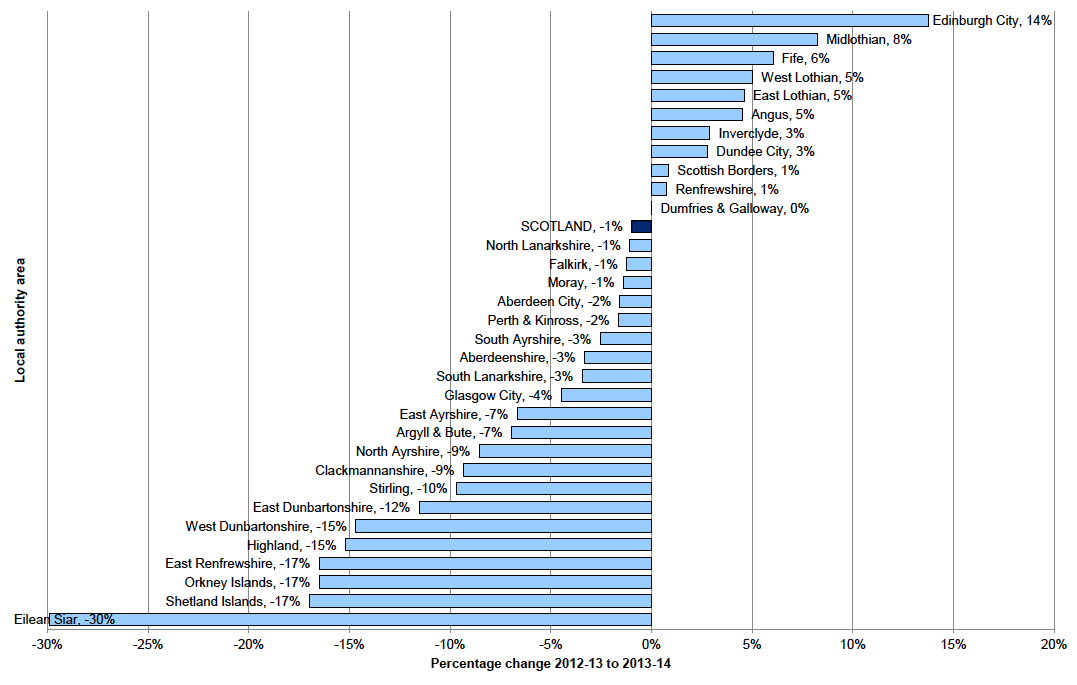
Chart 4: Change in total recorded crime between 2004-05 and 2013-14, by local authority area
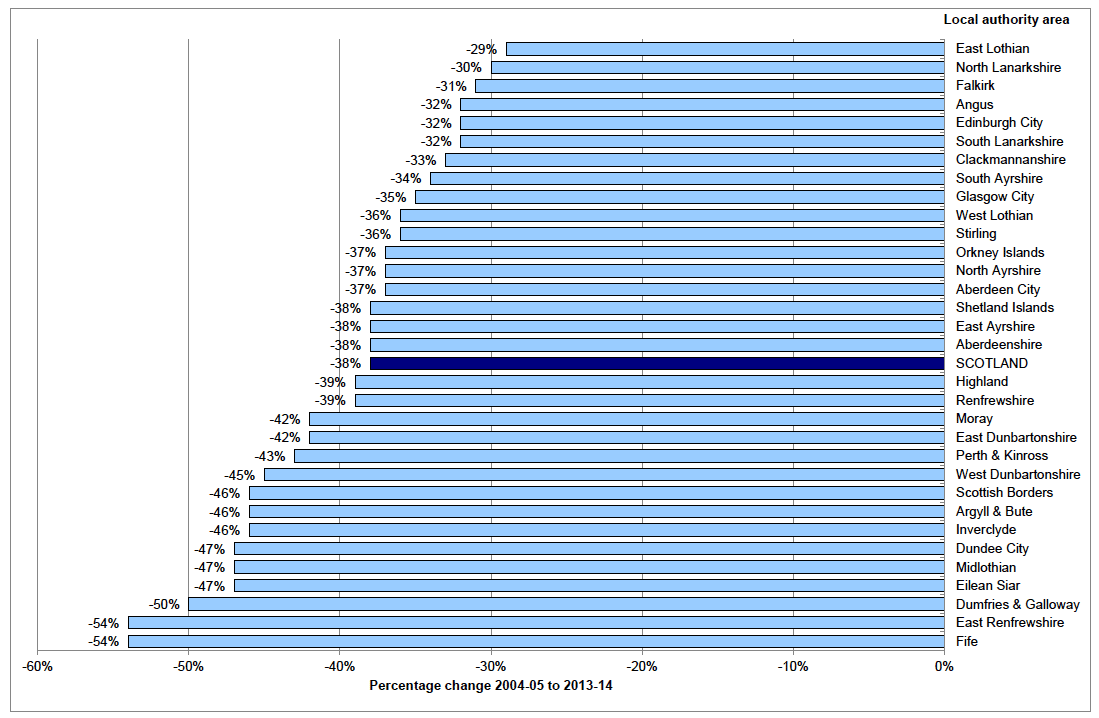
Crime rate per 10,000 population
There were 508 recorded crimes per 10,000 population in 2013-14, with urban areas recording the highest rates; Glasgow City (852 per 10,000 population) , Edinburgh City (731 per 10,000 population), Aberdeen City (678 per 10,000 population) and Dundee City (622 per 10,000 population).
Chart 5: Total number of recorded crimes per 10,000 population1 in 2013-14
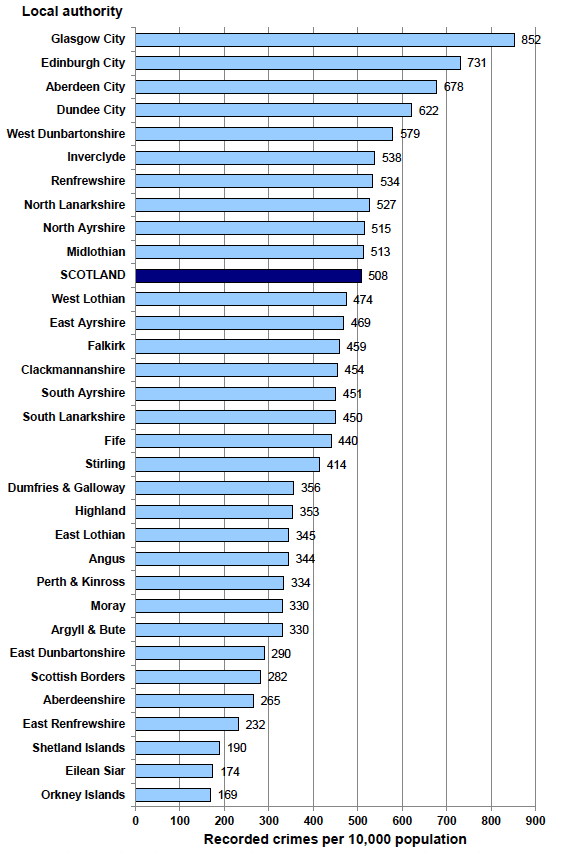
1. Population estimates are as at mid-year 2013 from the National Records of Scotland.
(http://www.gro-scotland.gov.uk/statistics/theme/population/estimates/mid-year/index.html)
Clear up rates
The clear up rate for recorded crimes in 2013-14 increased by 1 percentage point to 52%. This is the highest clear up rate since 1976, the first year for which comparable clear up rates are available.
Chart 6: Clear up rates for crimes recorded by the police by crime group, 19761 to 1994 then 1995-96 to 2013-14
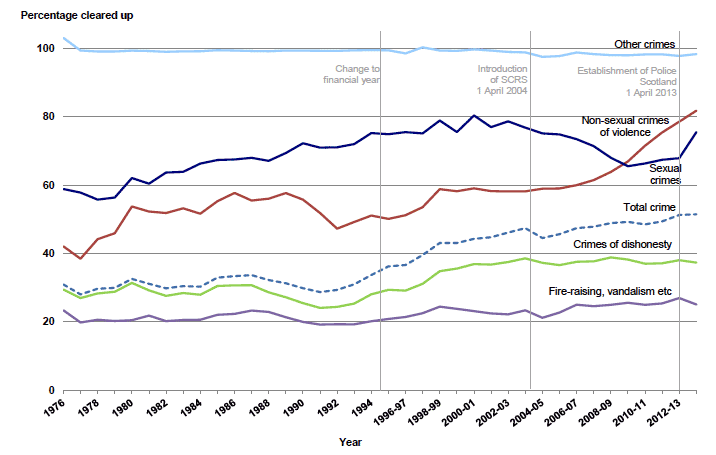
1. Comparable clear up rates for the present crime groups are not available prior to 1976.
Other publications relating to various crime types
Domestic abuse
There is no specific crime for domestic abuse - a range of different crimes can occur in domestic abuse incidents. The data on recorded crime does not contain enough detail for domestic abuse incidents to be identified and so a separate data collection is made each year to look at more detail at incidents of domestic abuse recorded by the police.
The Domestic Abuse Incidents Recorded by the Police in Scotland statistical bulletin series contains detailed information on domestic abuse incidents such as victim and perpetrator characteristics, relationship between victim and perpetrator, location of incident and the crimes recorded and cleared up as part of domestic abuse incidents.
We therefore recommend that users interested in Domestic Abuse Incidents should refer directly to the Domestic Abuse Incidents Recorded by the Police in Scotland bulletin series, available via the following link: http://www.scotland.gov.uk/Topics/Statistics/Browse/Crime-Justice/PubDomesticAbuse
The next Domestic Abuse Incidents Recorded by the Police in Scotland bulletin will contain data for 2013-14 and is scheduled for publication in early 2015.
Firearm offences
There are a range of offences which can occur involving a firearm and as with domestic abuse, it is not possible to identify these from the Recorded Crime dataset.
A separate data collection is made each year which gathers information on the crimes and offences committed, the type of weapon, victim and accused characteristics and location of incident.
The Recorded Crimes and Offences Involving Firearms, Scotland statistical bulletin series present statistics on crimes and offences recorded by the police in Scotland in which a firearm was alleged to have been involved or where a firearm was stolen.
We therefore recommend that users interested in crimes and offences involving firearms should refer directly to the Recorded Crimes and Offences Involving Firearms, Scotland bulletin series, available via the following link: http://www.scotland.gov.uk/Topics/Statistics/Browse/Crime-Justice/PubFirearms
The next Recorded Crimes and Offences Involving Firearms, Scotland bulletin will contain data for 2013-14 and is scheduled for publication in spring 2015.
This report will now examine the recorded crime and clear up rates attributable to each crime Group. Comparison will be drawn to the Scottish Crime and Justice Survey where relevant.
Reference is also made to the HMICS crime audit with more detailed information available in Annex 4.
GROUP 1 - NON SEXUAL CRIMES OF VIOLENCE
Number of Non-sexual crimes of violence recorded in 2013-14:
Between 2012-13 and 2013-14, the number of Non-sexual crimes of violence recorded by the police in Scotland decreased by 10%, from 7,530 to 6,785. These crimes are now at the lowest level since 1974.
Since 2004-05, the number of Non-sexual crimes of violence has decreased by more than a half (54%). (Chart 7 and Table 1). This crime group has been on a downwards trend since 2002-03 following a long period of increase.
Chart 7: Non-sexual crimes of violence recorded by the police, 19711 to 1994 then 1995‑96 to 2013-14
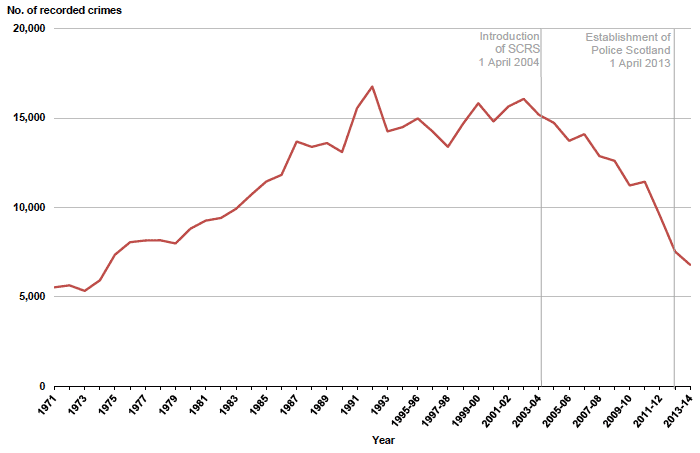
1. Crimes recorded for the present crime groups are not available prior to 1971.
In 2013-14, the highest rates of recorded Non-sexual crimes of violence per 10,000 population were found in Glasgow City (26 per 10,000 population), Edinburgh City (18 per 10,000 population) and Renfrewshire (17 per 10,000 population) (Table 7). This compares to the Scotland level figure of 13 crimes per 10,000 population.
Chart 8 shows the four categories in Non-sexual crimes of violence over the last ten years and gives an indication of the trend and scale of each category within Group 1.
Attempted murder & serious assault:
Attempted murder & serious assault is the largest category in Group 1, accounting for around half of all Non-sexual crimes of violence. This category has been on a downward trend over the ten year period and is now 57% lower than in 2004-05. All local authorities have recorded a decrease in this category over the ten year period.
This category decreased by 10% in 2013-14 and this trend was reflected in all but five local authority areas; Dumfries & Galloway, Dundee City, East Renfrewshire, Fife, and South Lanarkshire. In most of these areas the numerical change is small in each of these areas apart from Dumfries & Galloway, where there was a larger increase.
Chart 8: Non-sexual crimes of violence in Scotland, 2004-05 to 2013-14
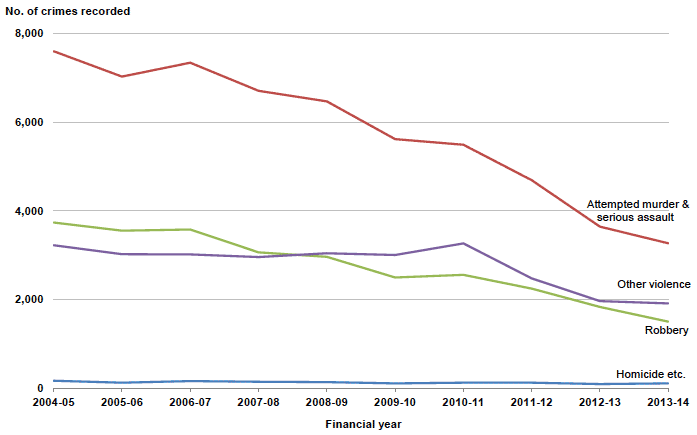
Robbery:
Robbery decreased by 18% between 2012-13 and 2013-14. This crime accounts for around a quarter of Non-sexual crimes of violence. Over the ten year period from 2004-05 to 2013-14, Robbery has seen a large decrease of 60%.
This decrease has been driven mainly by Glasgow City, Edinburgh City and Perth & Kinross which among them accounted for 88% of the decrease. There were seven local authorities in which an increase in Robbery was recorded in 2013-14. However these changes are based on small numbers.
Homicide etc:
It should be noted that the Homicide etc. category included in this bulletin contains the crimes of Murder and Culpable homicide (common law), as well as the crimes of Causing death by dangerous driving, Death by careless driving when under influence of drink or drugs, Causing death by careless driving, Illegal driver involved in fatal accident and Corporate homicide.
There was a 16% increase in Homicide etc. in 2013-14 from 91 to 106. However, the increase was due to increases in Causing death by dangerous driving (up by eight) and Causing death by careless driving (up by 12). Looking at Murder and Culpable homicide (common law), this figure has decreased by four since 2012-13.
A separate Homicide in Scotland bulletin is produced by the Scottish Government that contains more detailed information on the crimes of Murder and Culpable homicide (common law). These two crimes are collectively referred to as Homicide in this bulletin. The data in Homicide in Scotland bulletin are collected via a separate data collection from the police and are collected on an individual case basis. This means that characteristics of victims and accused, such as age and gender, as well as the circumstances of the homicide are collected and then included in the bulletin.
As the data in the Homicide in Scotland bulletin are collected separately from the data included in this bulletin, the data are extracted from police recoding systems at different time points which may result in reclassification of crimes, such as attempted murder to murder, which are not then reflected in this bulletin. In the Homicide in Scotland bulletin homicide cases are included against the year in which it is recorded by the police. This is not necessarily the year in which the crime took place, the year in which the accused is brought to trial for the crime, or the year in which the case is finally disposed of by the courts. This may lead to minor differences between the figures reported in Homicide in Scotland bulletin and this bulletin, as well as those published by the police.
We therefore recommend that users interested in Homicide statistics should refer directly to the Homicide in Scotland bulletin series, which can be accessed via the following link: http://www.scotland.gov.uk/Topics/Statistics/Browse/Crime-Justice/PubHomicide.
The next Homicide in Scotland statistical bulletin will contain data for 2013-14 and is scheduled to be published in December 2014.
Other violence:
The Other violence category includes crimes such as Threats and extortion, Cruel and unnatural treatment of children and Abduction. More detail is provided in Section 5.
Crimes in Scotland recorded as Other violence are at the lowest level since 1989. Other violence decreased by 3% from 1,964 in 2012-13 to 1,912 in 2013-14. This is a decrease of 41% since 2004-05. Over the ten year period, the vast majority (27) of local authorities have recorded a downwards trend in this category. Perth & Kinross recorded the largest numerical increase over the ten year period from 26 in 2004-05 to 62 in 2013-14.
The decrease in 2013-14 is mainly driven by a decrease in the number of crimes of Threats and extortion, and Child cruelty.
Eleven local authorities recorded an increase in this category although overall numbers are small. The largest increase was found in Fife, driven by an increase in Serious organised crime as a result of activity undertaken in targeting serious and organised crime. Police Scotland have identified that tackling serious and organised crime is one of their priorities. The increase in crimes recorded under the serious organised crime may be the result of activity undertaken in targeting serious and organised crime
Clear up rates for Group 1 crimes 2013-14:
The clear up rate for Group 1 crimes increased by three percentage points in 2013-14 from 79% to 82%, continuing the longer term trend. The clear up rate for Group 1 crimes ranged from 70% in Inverclyde to 100% in Clackmannanshire and Eilean Siar and 122% in Shetland Islands. Rates of over 100% can occur when crimes are cleared up in a different reporting period to the year in which they were recorded. However, clear up rates for these areas are based on small numbers of recorded crimes.
Commentary:
There are a number of operations and initiatives which are carried out by the police which may affect the trends in recorded crime.
On 27 November 2013, Operation Oak was launched in Aberdeen City. Working alongside partner organisations, the operation was launched to target violence and anti-social behaviour over five weeks covering the festive period.
In Eilean Siar, Highland, the Orkney Islands and the Shetland Islands, Operation Respect was also launched over the festive period, to reduce street violence and incidents linked to licensed premises. The operation has run for the past six years and involves uniformed and plain clothes officers working with local partners to keep people safe across the division.
It is anticipated that these police operations may have an impact on the number of crimes recorded by the police. Increases may occur where the police are present and come across crimes. However, increased police presence and raising of awareness may also deter crime.
Key points from the Scottish Crime and Justice Survey:
Of the 815,000 crimes measured by the SCJS in 2012-13, 236,000 (29%) were violent crimes. It is estimated that around 3% of adults in Scotland were a victim of violent crime in 2012-13.
In 2012-13, minor assaults made up the majority of SCJS violent crime (23%), followed by attempted assault (3%), serious assault (2%) and robbery (1%).
Further detail on the comparable crime set is available in Section 3.3. As outlined there and in Annex 5 of the 2012-13 SCJS, violent crime in the SCJS includes attempted assault, serious assault, minor assault and robbery, crimes which are included in Group 1 (Non-sexual crimes of violence) and Group 6 (Miscellaneous offences) in police recorded crime figures.
As outlined in Section 3.3, between 2008-09 and 2012-13, recorded violent crime figures in the comparable category decreased by 20%, while, for the same period, the SCJS estimates of violent crime decreased by 25%, a statistically significant change in the SCJS results. As indicated by Table 3, the SCJS is often better able to detect changes in survey estimates with greater certainty over longer timescales, due primarily to the small numbers of victims identified in the survey (343 for violent crime in 2012-13).
HMICS Audit
It should be noted that in the HMICS audit report, violent crime includes common assault.
Of the 1,766 crimes examined in the audit that resulted from the violent incidents, 94% were counted and classified correctly.
The chances are 19 in 20 that the 'true' value will fall within the range ± 2.5% from the sample results (i.e. approximately between 91.5% and 96.5%).
The audit found that a number of crimes had been under-counted (38) as well as over-counted (31). Most of the under-counted crimes were for common assault. Most of the over-counted crimes related to common assault and threatening and abusive behaviour.
A number of crimes (38) were classified incorrectly. The majority of these fell into three categories:
- common assault which should have been serious assault (14)
- serious assault which should have been attempted murder (7)
- thefts, or assaults and thefts, that should have been robberies (10)
The HMICS audit report notes that the 'classification of serious assault continues to be a challenge'. As noted in the report, a review is currently underway by Police Scotland in conjunction with the Scottish Government and other criminal justice partners, on the definition of serious assault.
Of the 2,238 violent incidents examined in the audit, 92% were closed correctly[6]. The chances are 19 in 20 that the 'true' value will fall within the range ± 1.9% from the sample results (i.e. approximately between 90.1% and 93.9%).
Almost half of the incidents which failed Test 1 involved a report of violence (usually a common assault) where the complainer was uncooperative. Around a third of the Test 1 fails involved a lack of information or update on the incident record to dispel the initial report of criminality.
GROUP 2 - SEXUAL CRIMES
Number of Sexual crimes recorded in 2013-14:
The number of Sexual crimes recorded by the police increased by 12% from 7,693 in 2012-13 to 8,604 in 2013-14. Sexual crimes have been on a generally upwards trend since 2008-09 and are now at the highest level since 1971, the first year for which comparable crime groups are available. However, it should be noted that as these are recorded crimes, this increase may be the result of increased reporting, including reporting of historic crimes, as victims find the courage to come forward and report such crimes to the police, particularly following increased media attention on high profile cases in recent years (Chart 9 and Table 1).
Tables A2 and A3 contain more detailed breakdowns for Sexual crimes. In Table A3, we can see that in 2013-14, 956 crimes of Lewd and Libidinous practices were recorded. These crimes will all relate to offences which occurred prior to the implementation of the Sexual Offences (Scotland ) Act 2009 on 1 December 2010, as the act replaced Lewd and Libidinous practices with specific sexual assault crimes. As a result, we know that these are historic offences. Similarly, there were 358 crimes of Sexual assault committed prior to 1 December 2010. There will of course be other Sexual crimes which were recorded in 2013-14 but which occurred in previous years but after the introduction of the Act. However, it is not possible to identify these separately to give a full picture of historic reporting.
Chart 9: Sexual crimes recorded by the police, 19711 to 1994 then 1995‑96 to 2013-14
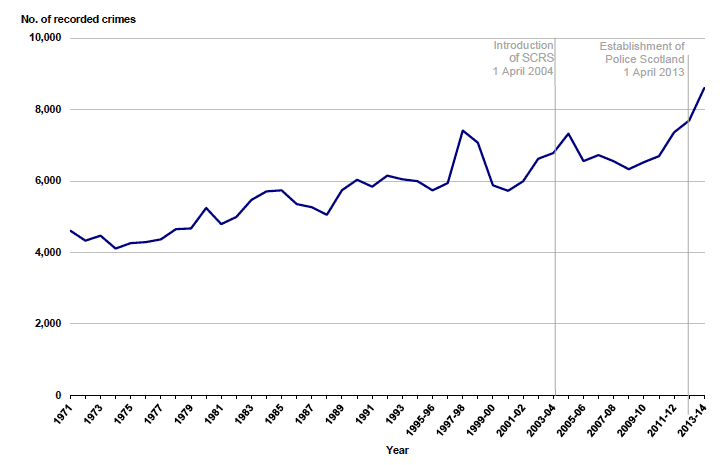
1. Crimes recorded for the present crime groups are not available prior to 1971.
While recorded crime in Scotland is not directly comparable with England & Wales or Northern Ireland due to differences in legislation and counting rules (see Annex 7), the overall trend for Sexual crimes is very similar across the UK.
Between 2012-13 and 2013-14, Sexual crimes in England and Wales increased by 20% compared with 12% in Scotland and 16% in Northern Ireland. Between 2008-09 and 2013-14 Sexual crimes in England & Wales increased by 28%, Northern Ireland increased by 21% and Scotland increased by 36%.
England & Wales and Northern Ireland both detail in their reports that the increase in recent years has been due to the increased media attention on historic abuse cases In particular, the England & Wales Crime statistics cite the effect of the Operation Yewtree investigation, connected to the Jimmy Savile inquiry, whereby more victims are coming forward to report offences to the police.
The largest number of Group 2 crimes per 10,000 population is in Fife (26 per 10,000 population), closely followed by Glasgow City (25 per 10,000 population). This compares to the Scotland level of 16 per 10,000 population. The high level of Sexual crimes in Fife in 2013-14 is due to a high proportion of historic crimes reported.
Chart 10 shows the four categories of Sexual crimes over the last ten years and gives an indication of the trend and scale of each category within Group 1.
The implementation of the Sexual Offences (Scotland) Act 2009 on 1 December 2010, resulted in a redistribution of Group 2 crimes among the subcategories. Comparisons over time of the breakdown of Sexual crimes should therefore be treated with caution. However, no new crimes were introduced as a result of the legislation and thus we do not consider there to be a break in the time series.
Chart 10: Sexual crimes in Scotland, 2004-05 to 2013-14
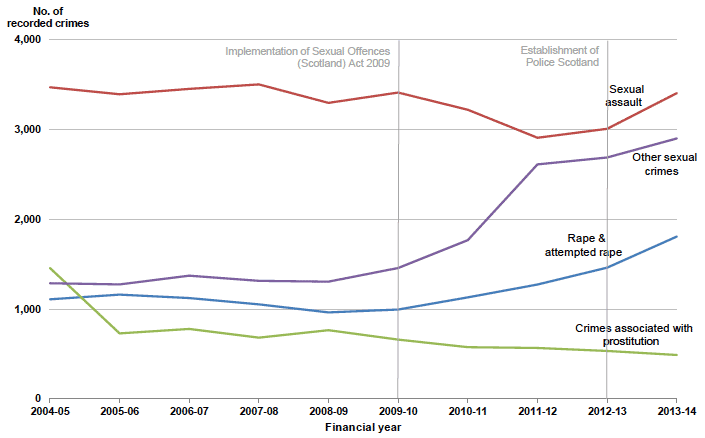
Sexual assault:
Sexual assault is the largest category of Sexual crimes, accounting for 40% of Sexual crimes in 2013‑14 and is a main driver behind the overall increase in Group 2 crimes. These crimes have increased by 13% since 2012-13. Dumfries & Galloway and Fife have seen the largest numerical increases accounting for 57% of the overall increase.
Rape & attempted rape:
Rape & attempted rape showed the largest percentage increase of Group 2 categories with there being a 24% increase in 2013-14 compared to 2012-13. It is likely that this increase is caused by historic reporting, particularly with increased media attention around sexual crimes in recent years which may have encouraged victims to report these crimes to the police. However, it should be noted that the Sexual Offences (Scotland) Act 2009 widened the definition of Rape and therefore comparisons with data prior to 2010-11 should be treated with caution.
Other sexual crimes:
Other sexual crimes increased by 8% between 2012-13 and 2013-14 However again, due to the implementation of the Sexual Offences (Scotland) Act 2009, comparisons with data prior to 2010-11 should be treated with caution.
However, there are a number of crimes such as Indecent communication and Voyeurism' which may have been recorded as Breach of the peace prior to the implementation of the Act, which therefore wouldn't have shown up as sexual crimes before December 2010. This may in part explain the increase in Other sexual crimes in 2011-12.
Crimes associated with prostitution:
Crimes associated with prostitution decreased by 8% between 2012-13 and 2013-14, continuing the long term trend. In 2005-06, there was a large decrease in these crimes. Following a murder, police took a different approach to the policing of crimes of prostitution in 2005-06, in order to maximise the information obtained from the community relating to this murder. As a result the decrease may somewhat artificial.
Clear up rates for Group 2 crimes 2013-14:
The clear up rate for Sexual crimes in Scotland has increased by 8 percentage points, in the last year, from 68% in 2012-13 to 76% in 2013-14. Clear up rates in each of the four categories in this crime group have also increased, with the largest increase in the clear up rate noted in Rape & attempted rape, increasing from 62% to 73%.
Across local authorities, the clear up rates for Sexual crimes ranged from 56% in East Renfrewshire to 104% in the Orkney Islands and 132% in Eilean Siar. Rates of over 100% can occur when crimes are cleared up in a different reporting period to the date in which they were recorded. However, clear up rates for these areas are based on small numbers of recorded crimes. Excluding the Orkney Islands and Eilean Siar, South Ayrshire recorded the highest clear up rate at 91%.
Commentary:
A number of operations and campaigns have been undertaken by Police Scotland to target Sexual crimes.
Operation Dash was launched by Police Scotland in February 2013 to scope the scale and extent of Child Sexual Exploitation (CSE) in the 12 local authorities of the legacy Strathclyde police force and working in partnership with Barnardo's.
As a result of intelligence information obtained, a full multi agency investigation was established to investigate criminality associated with CSE. Police Scotland continues to work with Local Authorities, Partnerships, Social work departments, health board areas, education services, the UK Border Agency (UKBA) and Barnardo's to improve awareness, prevention and intervention.
On 10 March 2014, a rape awareness campaign - 'We can stop it' was launched by Police Scotland. This month long campaign was aimed at increasing awareness and challenging perceptions about rape and was supported by groups including Rape Crisis Scotland, ASSIST, Scottish Women's Aid and White Ribbon Scotland.
It is anticipated that these operations and campaigns would increase awareness around Sexual crimes and encourage victims to find the courage to report such crimes to the police. Improved levels of reporting is likely to result in an increase in Sexual crimes.
HMICS Audit
Of the 897 crimes examined in the audit that resulted from the sexual incidents, 93% were counted and classified correctly.
The chances are 19 in 20 that the 'true' value will fall within the range ± 2.3% from the sample results (i.e. between 90.7% and 95.3%).
The audit found that a number of crimes had been under-counted (34) as well as over-counted (17).
Only 12 classification errors (out of 897 crimes examined) were made.
Several of the counting and classification errors related to the introduction of the Sexual Offences (Scotland) Act 2009 which came into force on 1 December 2010.
The thorough scrutiny of reports of rape within divisions and by the National Rape Review Team tends to ensure consistent and accurate recording.
Of the 1,200 sexual incidents, 89% were closed correctly[7]. The chances are 19 in 20 that the 'true' value will fall within the range ± 1.4% from the sample results (i.e. approximately between 87.9% and 90.4%). The majority of incidents were incorrectly closed due to the inclusion of insufficient information from which to make a judgement as to whether or not a crime has actually occurred. A third of these incidents has been referred to a specialist investigation unit. HMICS received assurances that investigations were on-going in these instances and a crime may be recorded at a later date, and noted that specialist investigation units should bear in mind that the Counting Rules require that crimes should be recorded as soon as practicable.
GROUP 3 - CRIMES OF DISHONESTY
Number of Crime of dishonesty recorded in 2013-14:
Crimes of dishonesty in Scotland have decreased over the last ten years, by 35% overall with all local authorities showing a decrease over this period. Crimes of dishonesty have been on a downwards trend since they peaked in 1991 following an upwards increase since 1971, the first year for which comparable crime groups are available.
In 2013-14, there was a slight increase of 1% in Crimes of dishonesty. These crimes account for half of all crime recorded in Scotland in 2013‑14. The main driver behind this slight increase was crimes of shoplifting which increased by 5% between 2012-13 and 2013‑14.
Chart 11: Crimes of dishonesty recorded by the police, 19711 to 1994 then 1995‑96 to 2013-14
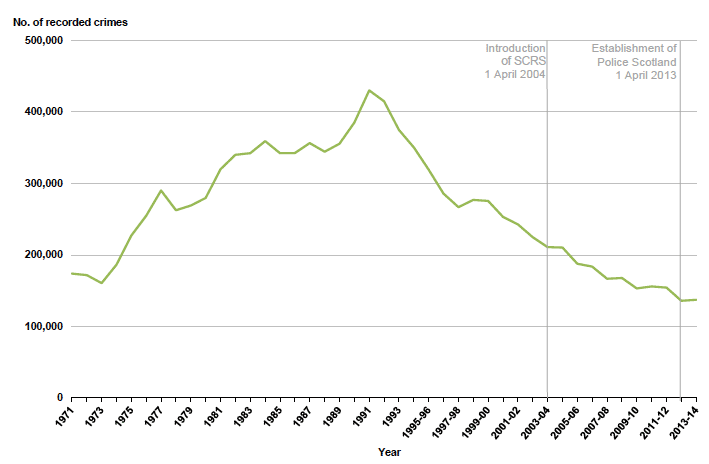
1. Crimes recorded for the present crime groups are not available prior to 1971.
The highest numbers of crimes of dishonesty per 10,000 population were in Edinburgh City (461 per 10,000 population), Glasgow City (425 per 10,000 population) and Aberdeen City (388 per 10,000 population). This compares with the 258 per 10,000 population recorded for Scotland as a whole.
Chart 12 shows the four largest categories in Crimes of dishonesty and gives an indication of the trend across these categories over the ten year period.
Other theft:
Other theft accounts for the largest proportion of Group 3 crimes at 43% in 2013-14. This category includes theft of pedal cycles and other thefts which are not classified elsewhere. Other theft has fluctuated over the ten year period (as shown in Chart 12), but is generally on a downwards trend with 2013-14 at a similar level to 2012-13.
Shoplifting:
Shoplifting accounts for a further fifth of crimes of dishonesty and increased by 5% between 2012-13 and 2013-14. Over the ten year period covered by the bulletin, Shoplifting is down by 3% overall however, this is the only category in Crime of dishonesty which is not on a clear downwards trend.
Chart 12: Crimes of dishonesty (showing four largest categories) in Scotland, 2004-05 to 2013‑14
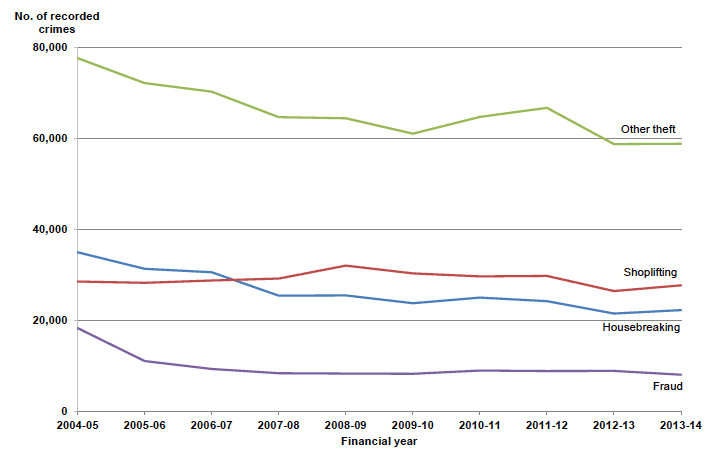
Twenty two of the 32 local authorities recorded an increase in shoplifting. The largest increase in Group 3 crimes was in Edinburgh City where there was an increase of 17% in 2013-14.
Housebreaking:
There was a 4% increase in Housebreaking in 2013-14, and Table A4 shows that this has been driven by an increase of 15% in housebreaking of non-dwellings. This includes garages, garden huts and sheds and outhouses.
In particular Edinburgh City saw a 39% increase in these crimes. Due to the increase in housebreaking, Police Scotland reviewed it's operation practice in relation to housebreaking in Edinburgh City, East Lothian, Midlothian, West Lothian and the Scottish Borders. Operation RAC was also instigated on 16 December across Scotland to tackle housebreaking over the festive period.
In 2013-14, the number of crimes of Domestic housebreaking recorded per 10,000 population was highest in Edinburgh City (69), Midlothian (50), Glasgow City (42) and Aberdeen City (40). Rural areas recorded much lower levels with Shetland Islands (6), Orkney Islands (2) and Eilean Siar (1) and recording the lowest level of Domestic housebreaking per 10,000 population in 2013-14 (Chart 13).
Fraud:
Crimes of Fraud decreased by 9% between 2012-13 and 2013-14, with all but five local authorities showing a decrease. Increases ranged from 5% in Stirling to 37% in Fife, while the largest proportional decrease was noted in Moray, 34% although the largest numerical decrease was in Edinburgh City.
Theft of a motor vehicle:
Theft of a motor vehicle also increased by 4% between 2012-13 and 2013-14. Again, the largest increase was found in Edinburgh City (58%). However, this is mainly due to a low figure in 2012-13 with the 2013-14 figure being more in line with data prior to 2012‑13.
Clear up rates for Group 3 crimes 2013-14:
Clear up rates for crimes of dishonesty decreased by one percentage point to 37% in 2013-14. Across local authorities, clear up rates ranged from 25% in East Renfrewshire to 65% in the Orkney Islands, although again, this is based on small numbers. Excluding the Orkney Islands, the highest clear up rate was in Fife at 56%.
Commentary:
There was increased media coverage around the 2013 festive period relating to the launch of a national housebreaking campaign by Police Scotland. Operation RAC aimed to work closely with partners at the Crown Office and Procurator Fiscal Service (COPFS) to ensure housebreakers are being appropriately dealt with and removed from communities where possible. This operation was launched on 18 December 2013 within Aberdeen City, Aberdeenshire, Clackmannanshire, East Lothian, Edinburgh City, Eilean Siar, Falkirk, Fife, Highland, Midlothian, Moray, North Lanarkshire, Orkney Islands, Shetland Islands, South Lanarkshire, Stirling, The Scottish Borders and West Lothian
It is likely that some of the increase in Housebreaking could be attributed to the resulting increased police action.
Operation Mondara, a multi-agency doorstep crime operation ran in September 2013 in conjunction with the UK wide Operation Rogue Trader, to target doorstep crime. As well as detecting these crimes, a crucial part of the operation was to raise awareness and encourage victims to come forward and report these crimes of Fraud.
Key points from the Scottish Crime and Justice Survey:
Of the 815,000 crimes measured by the SCJS in 2012-13, 579,000 (71%) were property crimes. It is estimated that around 15% of adults in Scotland were a victim of property crime in 2012-13.
In 2012-13, vandalism accounted for 27% of property crime, followed by other household theft (including bicycle theft, 21%), personal theft (excluding robbery, 13%), all motor vehicle theft related incidents (6%) and housebreaking (4%).
Further detail on the comparable crime set is available in Section 3.3. As outlined there and in Annex 5 of the 2012-13 SCJS, the comparable acquisitive crime group in the SCJS includes involves theft or damage to personal or household property (including vehicles) which are included in a number of recorded crime groups, including Group 3 (Crimes of Dishonesty) and Group 7 (Motor vehicle offences)
As presented in section 3.3, results show that recorded acquisitive crime decreased by 21% between 2008-09 and 2012-13, however, the SCJS estimates of acquisitive crime showed no statistically significant change between 2008-09 and 2012-13 (the apparent change from 64,000 to 73,000 is not statistically significant). Survey estimates on the comparable crime subgroups are based on small base sizes of respondents (272 for acquisitive crime in 2012-13) and as a consequence, there is less certainty around estimates.
HMICS audit
Of the 1,341 crimes examined in the audit that resulted from the housebreaking incidents, 95% were counted and classified correctly.
The chances are 19 in 20 that the 'true' value will fall within the range ± 2.4% from the sample results (i.e. between 92.6% and 97.4%).
The audit report stated that this 'good Test 2 compliance rate reflects the fact that housebreaking incidents appear to be scrutinised carefully by crime management units and are therefore more likely to be accurate'.
Most Test 2 errors related to the classification of the crime, and most of these related to whether the security of the building had been overcome (see page 24 of the HMICS report for further information).
Of the 1,664 incidents examined, 94% were closed correctly[8].
The chances are 19 in 20 that the 'true' value will fall within the range ± 2.1% from the sample results (i.e. between 91.9% and 96.1%).
Around half of the incidents which failed Test 1 did so because the incident record had not been updated with the results of the enquiry and the initial inference of criminality had not been dispelled. Around a quarter of Test 1 fails were thought to be crimes where the incident had not been followed up or the complainers had become uncooperative. Other Test 1 errors included incidents where the items stolen were deemed to be of no monetary value and therefore did not merit a crime report and where the owner of the property broken into was reporting the break-in 'for information only'.
Non-crime related incidents are those incidents reported to the police which never result in a crime report. Because no crime report results, this category was assessed against Test 1 only (that is, whether they were closed correctly as being non-crime related). 1,254 such incidents were examined, of which 87% were closed correctly. The chances are 19 in 20 that the 'true' value will fall within the range ± 2.7% from the sample results (i.e. between 84.3% and 89.7%).
Several of the incidents where a crime had clearly been committed but no crime record was found related to shoplifting. Often the goods stolen were of low value and officers elected not to record a crime, often because it was unlikely the offender would have been prosecuted. However, the decision to record a crime is distinct from the decision to prosecute. In these cases, HMICS viewed that a crime should still have been recorded.
Other incidents where a crime had clearly been committed but no crime record was found related to fraud. It seemed that some officers were uncertain how to respond to fraud allegations, particularly in relation to online fraud. The issue of fraud and cybercrime is one that HMICS has said they will consider more broadly in future. While the statistics in this bulletin show that crime is falling, there is a fear that some crime is being displaced and is now taking place online where it can be more challenging to identify, record and investigate. HMICS have stated that it will consider this type of crime further when setting their scrutiny programme in future.
Chart 13: Number of domestic housebreaking1 crimes recorded by the police per 10,000 population2 in 2013-14
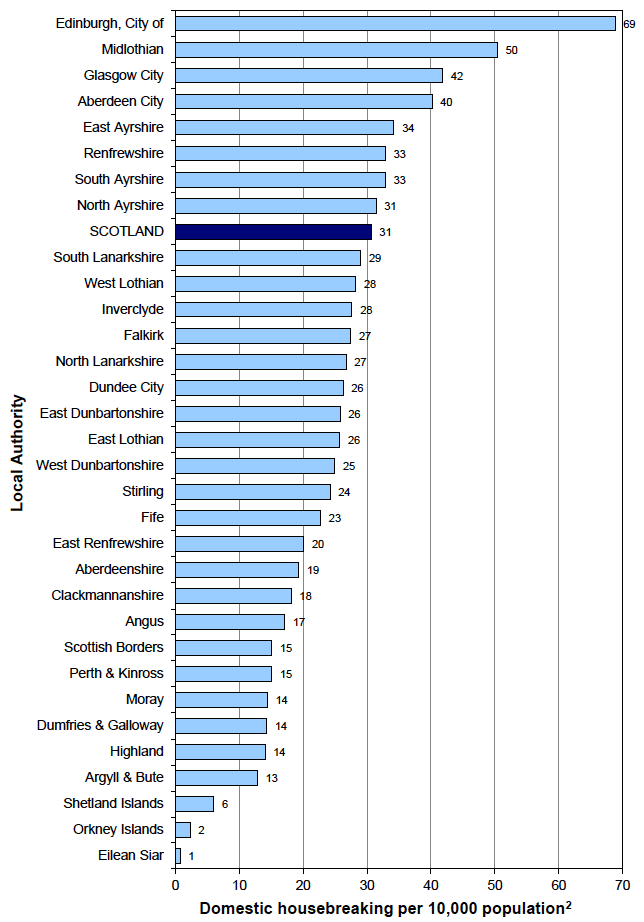
1. Includes dwellings and non-dwellings (including garages, sheds and outhouses) only.
2. Population estimates are as at mid-year 2013 from the National Records of Scotland.
(http://www.gro-scotland.gov.uk/statistics/theme/population/estimates/mid-year/index.html)
GROUP 4 - FIRE-RAISING AND VANDALISM ETC.
Number of crimes of Fire-raising, vandalism etc. recorded in 2013-14:
Fire-raising, vandalism etc. decreased by 9% between 2012-13 and 2013-14, largely driven by an 8% decrease in Vandalism which makes up the larger part of this crime group. This decrease continues the generally downward trend seen in this crime group since 2006-07 where Group 4 crimes peaked after a long term upwards trend.
Chart 14: Crimes of Fire-raising, vandalism etc. recorded by the police, 19711 to 1994 then 1995‑96 to 2013-14
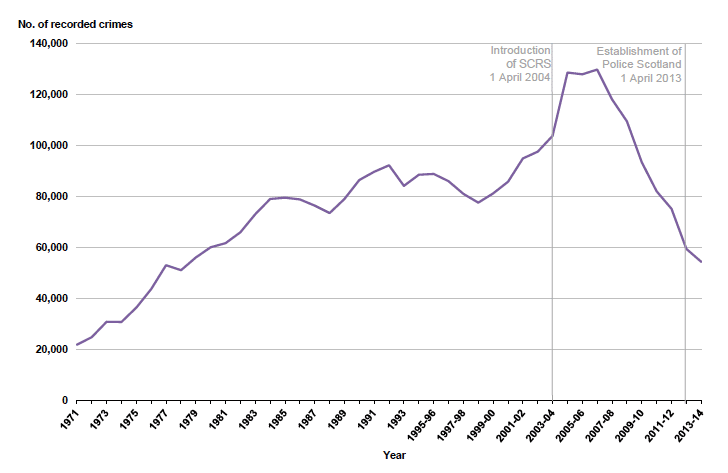
1. Crimes recorded for the present crime groups are not available prior to 1971.
The highest rates of Group 4 crimes per 10,000 population were found in Glasgow City (141 per 10,000 population), Dundee City (135 per 10,000 population) and Clackmannanshire (133 per 10,000 population). The highest rate of Fire-raising per 10,000 population was in West Dunbartonshire, at a rate of 13 per 10,000 population, with North Lanarkshire second highest at 8 per 10,000 population.
Vandalism etc:
Vandalism etc. which makes up 95% of Group 4 crimes, decreased by 8% between 2012-13 and 2013-14. Vandalism etc. has been decreasing steadily since a slight increase resulting from the introduction of the SCRS on 1 April 2004. This was expected to show an increase in the number of minor crimes recorded by the police and Group 4 crimes did show an increase as expected. Overall, there has been a 58% decrease in Vandalism since 2004-05 (Chart 15).
Due to the difference in scale of recorded crimes of Fire-raising and Vandalism etc., Charts 15 and 16 show these two categories separately to better highlight the individual trends over the past 10 years.
Only two local authority areas showed an increase in Vandalism between 2012‑13 and 2013‑14: Dundee City and Edinburgh City, increasing by 6% and 8% respectively.
Chart 15: Fire-raising in Scotland, 2004-05 to 2013-14
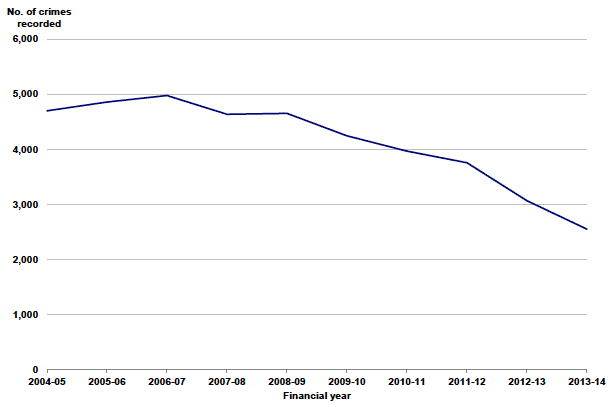
Charts 15 and 16 show that Fire-raising and Vandalism etc. are following similar decreasing trends over the last 10 years.
Fire-raising:
Fire-raising decreased by 17% between 2012-13 and 2013-14 and is 46% lower than in 2004-05 (Chart 16).
Chart 16: Vandalism etc. in Scotland, 2004-05 to 2013-14
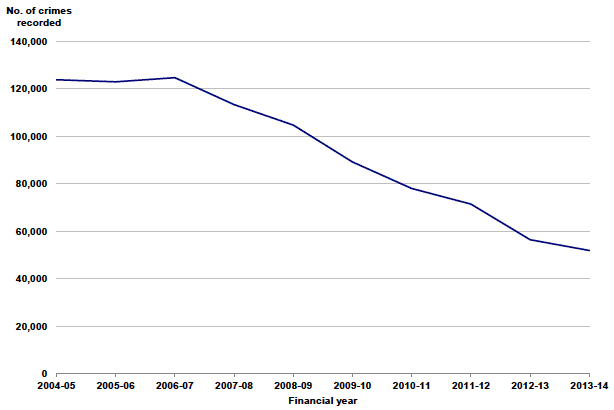
Clear up rates for Group 4 crimes 2013-14:
The clear up rate for Group 4 decreased by two percentage points to 25% in 2013-14, the lowest clear up rate of the five crime groups. The rate ranged from 14% in East Renfrewshire to 52% in Eilean Siar.
Key points from the Scottish Crime and Justice Survey:
As stated earlier, of the 815,000 crimes measured by the SCJS in 2012-13, 579,000 (71%) were property crimes and it is estimated that around 15% of adults in Scotland were a victim of property crime in 2012-13.
In 2012-13, vandalism accounted for 27% of property crime, followed by other household theft (including bicycle theft, 21%), personal theft (excluding robbery, 13%), all motor vehicle theft related incidents (6%) and housebreaking (4%).
Further detail on the comparable crime group is available in Section 3.3 and in Annex 5 of the 2012-13 SCJS. Vandalism is included in recorded crime figures within Group 4 (Fire-raising, vandalism etc).
As shown in section 3.3, between 2008-09 and 2012-13, recorded vandalism figures fell by 46%, while SCJS estimates decreased significantly by of 37%. Compared to the violent crime and acquisitive crime groups, vandalism estimates are based on larger samples of respondents (760 in the 2012-13 survey), leading to greater certainty around changes in the short and medium term.
GROUP 5 - OTHER CRIMES
Number of Other crimes recorded in 2013-14:
Other crimes have increased by 1% between 2012-13 and 2013-14, an increase largely driven by an increase of 3% in drug crimes.
Chart 17: Other crimes recorded by the police, 19711 to 1994 then 1995‑96 to 2013-14
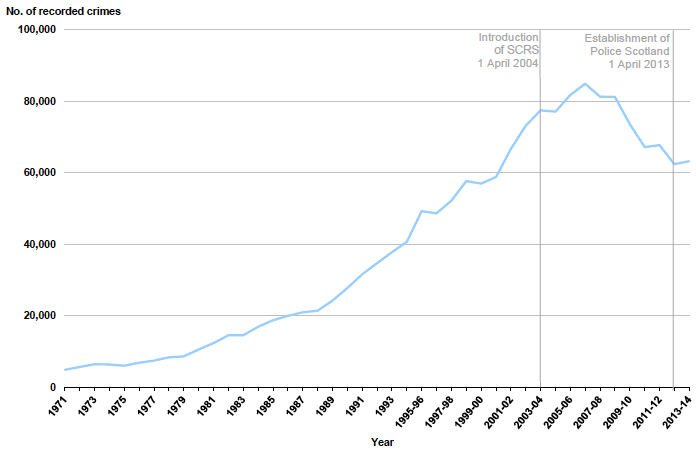
1. Crimes recorded for the present crime groups are not available prior to 1971.
Local Authority analysis:
In 2013-14, the highest rates of Other crimes per 10,000 population were in Glasgow City (235 per 10,000 population), Inverclyde (207 per 10,000 population) and West Dunbartonshire (184 per 10,000 population). This compares with the Scotland level of 119 per 10,000 population.
Chart 18 shows the four categories included in Group 5 and gives an indication of the scale of each category as well as showing the trends across the ten year period.
Drug crimes:
Drug crimes accounted for 56% of Group 5 crimes and these crimes increased by 3% between 2012-13 and 2013-14. This was driven by a 4% increase in Possession of drugs crimes, which account for 85% of all drug crimes. Inverclyde recorded the largest increase in drug crimes (52%), followed by Midlothian (33%) and Perth & Kinross (25%). The increase in drug crime in Inverclyde was driven by an increase in drug possession detections. Police Scotland have noted that there was a high level of proactivity by officers regarding these crimes in these areas. This may have impacted on the number of crimes coming to the attention of the police and thus on these statistics.
The increase in Inverclyde has resulted in this local authority recording the highest number of drug crimes per 10,000 population (160 per 10,000 population). In previous years, the highest rate has been in Glasgow City which is now the second highest (144 per 10,000 population). This compares with the Scotland level figure of 67 drug crimes recorded per 10,000 population.
Crimes against public justice:
Crimes against public justice, which includes Bail offences, resisting arrest and wasting police time increased by 1% between 2012-13 and 2013-14, mainly driven by increases in Bail offences, other than absconding and re-offending and Resisting arrest. Police Scotland have stated that their approach to managing domestic abuse offenders will likely have caused an increase in bail offences.
Chart 18: Other crimes in Scotland, 2004-05 to 2013-14
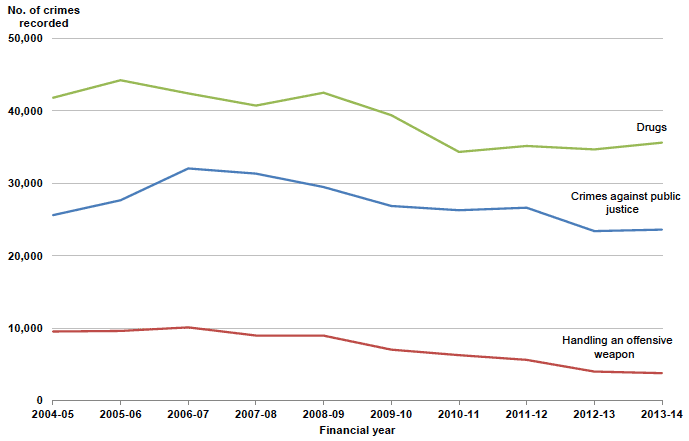
Handling an offensive weapon:
Crimes of Handling an offensive weapon decreased by 5%, from 4,015 in 2012-13 to 3,795 in 2013-14. This continues the downward trend seen since 2006-07 when these crimes were at the highest level since 1971, the first year for which comparable data are available. There has been a 62% decrease since 2006-07.
The rate of crimes of Handling an offensive weapon per 10,000 population was highest in West Dunbartonshire (16 per 10,000 population), Glasgow (14 per 10,000 population) and Dundee City and Edinburgh City (each 9 per 10,000 population). This compares with the Scotland level of 7 per 10,000 population.
Clear up rates for Group 5 crimes 2013-14:
Clear up rates for Group 5 crimes are generally close to 100% since these consist of many crimes for which someone is 'caught in the act'. In 2013-14, the overall clear up rate for Scotland was 98%, a level which has remained consistent since 2007-08.
Commentary:
No Knives, Better Lives (NKBL) is a Scottish Government youth initiative that works with local partners (council, police, youth groups) to deliver a range of activities in schools and communities to get the message across to young people 'on the cusp' of picking up a knife about the dangers and consequences of carrying a knife, and encourages them to make more positive life choices. Over the last five years, it has been operating in eleven areas across Scotland - Inverclyde, Renfrewshire, Clackmannanshire, West Dunbartonshire, South Lanarkshire, North Lanarkshire, Glasgow, Edinburgh, East Ayrshire, North Ayrshire and West Lothian. NKBL is now available to all Local authorities on an opt in basis.
GROUP 6 - MISCELLANEOUS OFFENCES
Number of Miscellaneous offences recorded in 2013-14:
The total number of Miscellaneous offences increased by 2%, from 203,063 in 2012‑13 to 207,190 in 2013-14. Please note that a number of changes have occurred in this offence group and these are detailed in Annex 2.
The Other miscellaneous offences category is generally to categorise a large number of offences which in themselves, are too small to consider reporting separately. However, as this category has become rather large, the category was looked at more closely and two particular offences were found to be large enough to report individually: Consumption of alcohol in designated places, byelaws prohibited, and Urinating etc. A separate category of Urinating etc. has created, while Consumption of alcohol in designated places, byelaws prohibited was found to sit with the Drunkenness offences which has been renamed accordingly to Drunkenness and other disorderly conduct.
Due to a number of anomalies found in the data, there is a break in the time series at 2008-09. However, the comparability issues relate only to Drunkenness and other disorderly conduct and to Other miscellaneous offences. However, the two individual crime codes affecting these two categories are very small. All other categories have been assessed as comparable with the long term time series, including Common assault, Breach of the peace etc. and Urinating etc. Detailed information on the comparability of Group 6 are available in Annex 2.
Chart 19: Miscellaneous offences in Scotland, 2004-05 to 2013-14
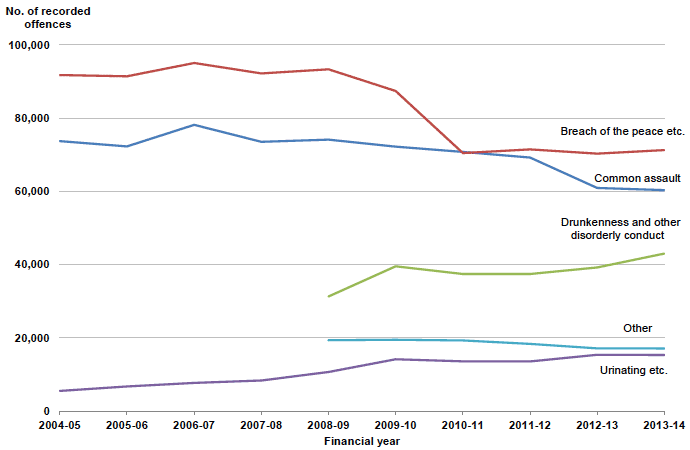
Breach of the peace etc:
Breach of the peace etc. is the largest category in this group accounting for a third of miscellaneous offences in 2013-14. This offence category includes Breach of the peace, Threatening or abusive behaviour, Stalking, Offensive behaviour at football and Threatening communications. A further breakdown of Breach of the peace etc. into its component parts is available in Table A8.
There was a 1% increase in Breach of the peace offences between 2012-13 and 2013-14. However this figure a fifth lower than the 2004-05 figure of 91,772.
Common assault:
There was a 1% decrease in Common assault between 2012-13 and 2013-14. Eleven local authorities noted an increase in common assault with the largest increases in the Scottish Borders (40%) and Dumfries & Galloway (23%). The largest decreases were in Shetland (46%, from 204 in 2012-13 to 111 in 2013-14) and Aberdeen City (17%, from 4,247 in 2012-13 to 3,507 in 2013-14).
The rate of Common assault per 10,000 population was highest in Glasgow City (166 per 10,000 population), Aberdeen City (154 per 10,000 population) and Dundee City (150 per 10,000 population).
Drunkenness and other disorderly conduct:
Drunkenness and other disorderly conducts includes offences such as Drunk and Incapable, Disorderly on licensed premises, Refusing to quit licensed premises and Consumption of alcohol in designated places, byelaws prohibited. For further information on the classification of crimes and offences, please see Section 5.
Drunkenness and other disorderly conduct increased by 10% between 2012-13 and 2013-14. The highest rates of Drunkenness and other disorderly conduct per 10,000 population were recorded in Glasgow City ( 395 per 10,000 population), Inverclyde (202 per 10,000 population) and North Lanarkshire (130 per 10,000 population). In previous publications, the offences of Consumption of alcohol in designated places, byelaws prohibited, was included in the Other category within this group. However, as this offence is fairly large, it has been removed from the Other category and was found to sit best within the Drunkenness category. To reflect this change, the category has been renamed Drunkenness and other disorderly conduct. The figures shown against this category have been revised to ensure comparability across the whole time series.
It should be noted that during the quality assurance exercise carried our prior to publication, an issue was found with offences of Disorderly on licensed premises, which have in the past been double counted in legacy Tayside. It has been possible to correct these data back to 2008-09 but corrections cannot be made prior to this and as a result the category Drunkenness and other disorderly conduct is not considered comparable for years prior to 2008-09.
Urinating etc:
Offences of Urinating etc. recorded in 2013-14 remained at the same level as 2012‑13. The highest rates of Urinating etc. per 10,000 population were recorded in Glasgow City (112 per 10,000 population), Aberdeen City (46 per 10,000 population) and Inverclyde (40 per 10,000 population). In previous publications, the offence of Urinating etc. was included in the Other category within this group. However, as this offence is fairly large, it has been removed from the Other category and has been included as a category in its own right.
Racially aggravated harassment and conduct:
The Other category in Group 6 contains offences of Racially aggravated harassment and Racially aggravated conduct and Table A9 shows these offences for the last ten years. While these are specific racially aggravated offences, they do not account for all racially aggravated crimes such as assault or vandalism.
The Racist Incidents Recorded by the Police in Scotland statistical bulletin series contains more detailed information on Racist Incidents such as victim/complainer and perpetrator characteristics, location of incident and the crimes recorded and cleared up as part of racist incidents.
We therefore recommend that users interested in Racist Incidents should refer directly to the Racist Incidents Recorded by the Police in Scotland bulletin series, available via the following link: http://www.scotland.gov.uk/Topics/Statistics/Browse/Crime-Justice/PubRacistIncidents
The next Racist Incidents Recorded by the Police in Scotland bulletin will contain data for 2013-14 and is scheduled for publication in spring 2015.
Key points from the Scottish Crime and Justice Survey:
As stated earlier, of the 815,000 crimes measured by the SCJS in 2012-13, 236,000 (29%) were violent crimes and it is estimated that around 3% of adults in Scotland were a victim of violent crime in 2012-13.
In 2012-13, minor assaults made up the majority of SCJS violent crime (23%), followed by attempted assault (3%), serious assault (2%) and robbery (1%).
Further detail on the comparable crime set is available in Section 3.3. As outlined there and in Annex 5 of the 2012-13 SCJS, violent crime in the SCJS includes attempted assault, serious assault, minor assault and robbery, crimes which are included in Group 1 (Non-sexual crimes of violence) and Group 6 (Miscellaneous offences) in police recorded crime figures.
As presented in section 3.3, between 2008-09 and 2012-13, recorded violent crime figures in the comparable category decreased by 20%, while, for the same period, the SCJS estimates of violent crime decreased by 25%, a statistically significant change in the SCJS results. As indicated by Table 3, the SCJS is often better able to detect changes in survey estimates with greater certainty over longer timescales, due primarily to the small numbers of victims identified in the survey (343 for violent crime in 2012-13).
HMICS audit
Of the 504 hate crimes examined, 94% were counted and classified correctly.
The chances are 19 in 20 that the 'true' value will fall within the range ± 2.2% from the sample results (i.e. approximately between 91.8% and 96.2%).
Five crimes were under-counted and six crimes were over-counted. There were no recurring themes in relation to counting errors for hate crime However, the majority of classification errors related to the same technical issue around the classification of crimes between s.50(a) (1B) of the Criminal law Consolidation (Scotland) Act 1005 and s.38 of the Criminal Justice and Licensing (Scotland) Act 2010.
The Test 1 compliance rate of 97% for hate crime was the best of the four crime categories audited.
The chances are 19 in 20 that the 'true' value will fall within the range ± 1.5% from the sample results (i.e. approximately between 95.5% and 98.5%).
Test 1 failures tended to relate to a lack of information or update on the incident record to dispel criminality. In several incidents, the complainer became uncooperative but a crime should nonetheless have been recorded. In a few incidents, a crime had clearly taken place but we could find no trace of a crime record.
As was noted earlier, in the HMICS audit report, violent crime includes common assault. Please refer to the Group 1 - Non-sexual crimes of violence section.
GROUP 7 - MOTOR VEHICLE OFFENCES
Number of Motor vehicle offences recorded in 2013-14:
During the quality assurance exercise carried out to assess the comparability of data from the new Police Scotland ScOMIS system with existing data from legacy forces, a number of anomalies have been identified in the data. There are a number of data sources previously included in some of the legacy force data which are not reported in ScOMIS such as the Safety Camera Partnership, Vehicle Defect Rectification Scheme and DVLA tickets. In addition to the changes in data reported to SG, the issue has highlighted inconsistencies with legacy data reporting. Annex 2 highlights all of the issues affecting Group 7 crimes in detail.
There are two crime categories in this group which are fully comparable across the time series: Dangerous and careless driving and Driving under the influence. However, as there are a number of issues affecting the other categories, totals for motor vehicle offences for 2013-14 cannot be compared with previous years.
We are investigating how to rectify these problems and obtain data for Group 7 which is comparable over time, but in the meantime, only data for 2013-14 is presented in tables with the exception of Dangerous and careless driving and Driving under the influence which are shown for the whole ten year time series.
The issues identified in Group 7 also mean that it is not possible to obtain a comparable total for all offences.
Dangerous and careless driving:
There has been a 9% increase in Dangerous and careless driving between 2012‑13 and 2013-14 with 21 local authorities showing an increase in this time period. The highest number of offences of Dangerous and Careless driving per 10,000 population was recorded in Dumfries & Galloway (45 per 10,000 population), followed by Argyll & Bute (43 per 10,000 population) and Glasgow City (38 per 10,000 population)
Driving under the influence:
There was a 6% decrease in Driving under the influence between 2012-13 and 2013‑14. The rate of offences of Driving under the influence per 10,000 population was highest in Argyll & Bute, Highland and Shetland Islands, each at 16 per 10,000 population.
Seat belt offences:
Seat belt offences increased by 15% between 2012-13 and 2013-14. These offences are on an upwards trend over the comparable period 2008-09 to 2013-14, however, this is most likely because such offences may often be targeted in local driving initiatives.
Mobile phone offences:
Mobile phone offences have been steadily increasing over the period 2008-09 to 2013-14, with a 16% increase since 2012-13. Again, these offences may be influenced by police initiatives on safer driving.
Commentary:
The police frequently run road safety initiatives to tackle problems such as drunk driving, Seat belt and Mobile phone offences as well as ensuring vehicles are safe to be on the road.
An example of this is in Eilean Siar, Highland, the Orkney Islands and the Shetland Islands. There have been a range of road safety initiatives as part of Operation Route, an on-going campaign aimed at increasing road safety and deterring travelling criminals. In addition to this, they highlighted road users to the dangers of drink and drug driving at the start of the national Festive Drink Drive campaign which began on 6 December 2013, with the aim of the campaign to reduce the number of those committing such offences and to reduce the number of casualties on the roads. Awareness of this may in part explain the decrease in Driving under the influence offences recorded in these local authorities.
Contact
Email: Jan Young
There is a problem
Thanks for your feedback